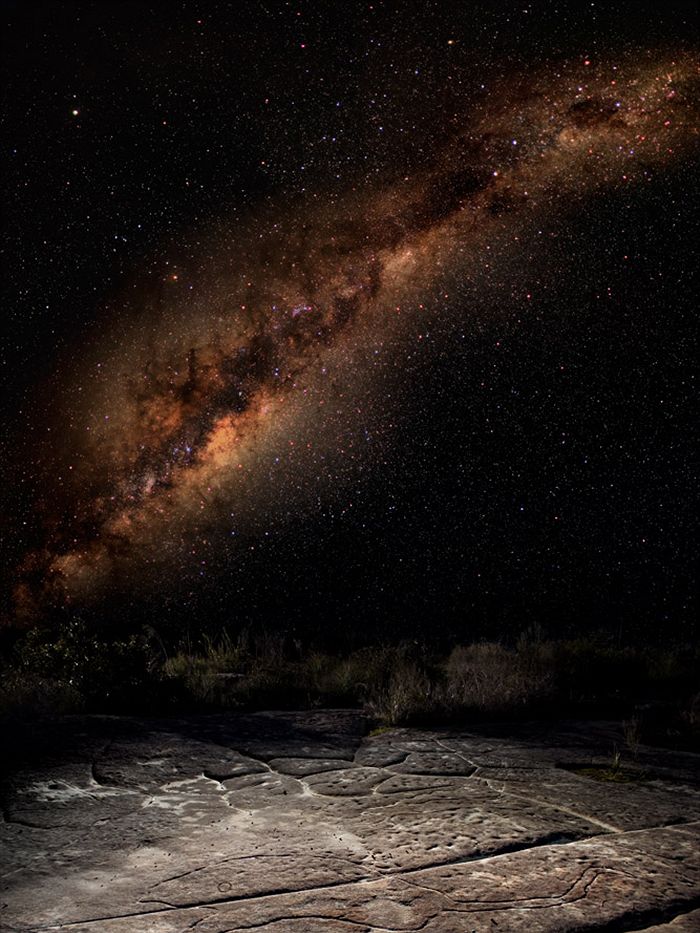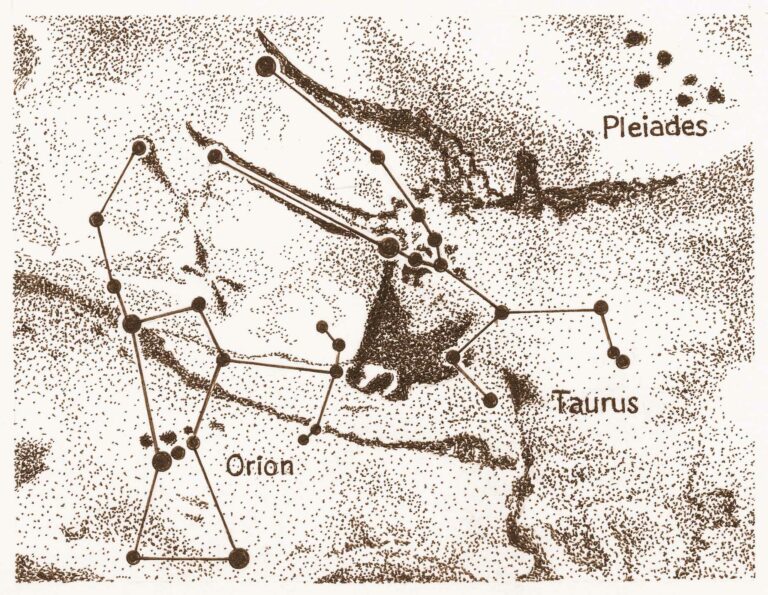by Jimena Pereira Paz, Kit Archibald, Dr Hannah Dalgleish
Should dark skies be considered in the context of human rights?
Humanity has had a deep relationship with the night sky throughout human history. Despite the undeniable influence the stars have had on art, culture, and indigenous knowledge systems, this age-old connection is fading due to increasing light pollution, while is also causing environmental damage and ecological harm.
In the existing literature, arguments typically focus on addressing light pollution from socioeconomic, environmental or human health perspectives, but overall fail to situate a pristine night sky as a human rights concern. Here, we argue that the loss of dark skies is infringing the rights to take part in cultural life and enjoy cultural heritage, and to access a clean, healthy and sustainable environment.
Introduction
Light pollution is a global issue, stretching across land, below water, and even as far as beyond the Earth’s atmosphere. Artificial light at night causes a wide array of problems including ecosystem disruption, altered chemical behaviours in humans and other living things, and a loss of access to dark nocturnal environments, the night sky included. However, in the literature, arguments against light pollution thus far have neglected to consider it as a human rights problem.
By reviewing light pollution literature and its associated cultural, social and ecological consequences, we explore whether access to a dark night sky should be a human right. Firstly, we discuss the influence the night sky has had on human culture and art throughout history. We argue that the loss of dark skies, along with the cultural practices and knowledge systems ingrained within, is infringing the right to take part in cultural life, and to access and enjoy cultural heritage. When considering the loss of the night sky for indigenous peoples, we maintain that this is a form of cultural genocide (Hamacher et al. 2020), violating the right of indigenous peoples to self-determination and to conserve their relationship with the natural world. Furthermore, we discuss whether living under a polluted night sky is breaching the human right to a clean, healthy and sustainable environment.Finally, dark sky tourism (DST) – as explored in Auala & Dalgleish (2023) – may be a promising initiative to support the protection of dark skies and its stories, by raising awareness and generating support for future legislation.
Astronomy in culture and art
For as long as humans have been observing the sky, astronomy has informed culture as much as culture has informed astronomy. Cultural ties to astronomy can be found across ancient civilisations throughout time and place (Gullberg et al., 2020), where celestial objects were revered as sources of power and wisdom, and the natural cycles of night and day were deeply respected. The Egyptians, Babylonians, Celts, and Incas, for example, all drew upon the arrangement of stars in the sky for religious, navigational, and storytelling purposes. We also find occurrences of strong intangible connections between the nightscape and the human, finite, existence. The Irish once held the view that life continues after death, while the Welsh and Inca believed in cycles of death and rebirth. This is in contrast to the Greek beliefs of people transforming into stars and living on for eternity. An unpolluted view of the universe produces an extraordinary imagination in the collective consciousness on a spiritual and transcendental level.
Light pollution encroaches upon remote locations, often home to indigenous communities. This can be considered in the context of the 2007 Starlight Declaration, which states, “an unpolluted night sky … should be considered an inalienable right equivalent to all other socio-cultural and environmental rights.” Limiting a cultural group’s access to their night sky and associated cosmologies is effectively erasing these cultural practices and knowledge systems. An example of this put forward by Hamacher, et al. (2020) is the Warrumbungle National Park in Australia, home to the Kamilaroi people. The Aboriginal group still gains and transmits complex knowledge systems regarding the night sky, and their practices depend on an unobstructed view of the Milky Way. Skyglow produced by surrounding cities and flares from fracking threaten the ability to observe The Emu in the Sky, an integral part of their culture. We need to rethink how we illuminate cities, where more than half of the world’s population live, so that we can guarantee continuous access to a dark night sky, to all citizens.

In another perspective, the United Nations declaration on the rights of indigenous peoples (2007) recognises their right to maintain, control, protect and develop their cultural heritage, traditional knowledge and cultural expressions. The UN also declares the right to their ancestral lands and territories, including their natural resources, and the right to be asked for their free, prior and informed consent before adopting and implementing legislative or administrative measures that may affect them. Nevertheless, no informed consent is being put forward regarding light pollution, despite it clearly being an issue of cultural and natural conservation. In the context of indigenous (and environmental) ethics, should the contamination of the night sky be treated as seriously as the pollution of a river?
The night sky can also be viewed as our one true common artistic heritage, reflected in the earliest cave paintings created tens of thousands of years ago, spanning to more modern times. Astronomical phenomena have been depicted in countless artistic works – from Walt Whitman’s poetry to Van Gogh’s paintings – evoking feelings of beauty, impermanence, and curiosity around our place in the cosmos. With light pollution increasing as fast as 9.6% every year (Kyba et al, 2023), could these culture defining and time defying artworks still be produced today?

Images: La salle des taureaux (the bulls room) in the Lascaux cave, France, is believed to represent the constellations Orion, Taurus and the Pleiades (see Rappenglück, 1999)
Source: Brian Campbell https://www.flickr.com/photos/67199489@N07/6117112969/; https://treeofvisions.wordpress.com/2015/04/29/paleo-astronomy/]

Light pollution: a threat for planetary health
A pristine celestial nightscape is unreachable for the vast majority of people. The sharp rise in light pollution in recent years results from the excessive and inefficient use of blue emitting LEDs. Given that 60% of Europeans and nearly 80% of North Americans cannot observe the Milky Way (Falchi et al., 2016), the newest generations inhabiting the planet are becoming less likely to encounter a naturally dark sky. This problem is not only limited to cities but extends to more remote locations, where light from populated areas contaminate the sky due to skyglow.
Artificial light is also a nuisance from space, where vast numbers of satellite megaconstellations have created a new source of light pollution from above. This is of particular concern given that the regulation of artificial satellites in lower Earth orbit is limited, and the private companies who typically launch them are often not held accountable (Venkatesan, et al. 2020). If we recognise space as a scientific and cultural resource for humanity, should we defend its exploration and use in favour of the interests of all global citizens?
Life on Earth is regulated by light-dark cycles; maintaining dark skies is beneficial to the health of humans and other living things. Artificial light at night disrupts this circadian rhythm, with detrimental consequences on flora and fauna, posing a serious threat to biodiversity (Holker et al, 2021). This is especially concerning given the sixth mass extinction of present times (United Nations, 2021). Further, the UN states: “the unsustainable management and use of natural resources, the pollution of air, land and water, … the resulting loss of biodiversity and the decline in services provided by ecosystems interfere with the enjoyment of a clean, healthy and sustainable environment and that environmental damage has negative implications, both direct and indirect, for the effective enjoyment of all human rights”. This suggests that the negative impacts of light pollution regarding cultural rights and environmental rights are not separated, but interrelated.
Reconnecting with the stars: dark sky tourism
Surprisingly, light pollution is overlooked by the majority of nature conservation organisations, and is little known in political or public spheres. The conservation of the night sky relies mainly on small, yet dedicated communities of dark sky enthusiasts, brought together by organisations like DarkSky International or the Starlight Foundation. The central goals of these organisations are to raise awareness about artificial light at night, bring forward improvements for urban lighting, and certify dark sky locations which helps to mitigate light pollution. These activities go hand in hand with dark sky tourism, which often takes place in remote locations giving people the chance to stargaze under unpolluted skies. Some destinations include storytelling as part of their offering, alongside opportunities to learn about local mythology. This could not only be a powerful tool to conserve dark sky locations and generate awareness about its value, but has also been shown to contribute to sustainable socioeconomic development (Auala & Dalgleish, 2023), and therefore, to a full enjoyment of all human rights. Tourism also makes dark sky conservation more appealing to businesses and governments, where economic advantages are concerned.
If DST can empower indigenous and rural communities, and other minorities – via tourism and education – dark sky tourism enterprises could be the key to reducing light pollution. Yet, as these activities become more widespread, it is important to maintain respect for the lands and ecosystems where they take place, so that they do not become destinations subject to harmful overtourism and significant carbon emissions.
Summary
The night sky has been humanity’s faithful companion since prehistoric times. It has informed our traditions, our stories, our art and our understanding of the world in innumerable ways. This connection is threatened by light pollution, which is restricting most people’s access to an unpolluted night sky. The erasure of dark skies can be associated with ideas of “progress”, “growth” or “safety”, often exacerbated by industrialisation, urban expansion, advertising, and other commercial interests. Currently, there are no international regulations regarding outdoor lighting, advertising, or artificial satellites that contemplates this threat and aims to mitigate its effects. Not only is this a loss for humanity, but it has direct links to several human rights: (1) a human right to enjoy and take part in cultural life (2) a human right to a clean, healthy and sustainable environment, and (3) a human right of indigenous peoples to maintain, control, protect and develop their cultural heritage.
Given this evidence, we argue that the starscape should be included in the conversation on human rights, and furthermore should be recognised as a part of the global commons. Conserving dark skies is of utmost importance, not only for cultural or health reasons, but for the more-than-human species which do not have a voice. Promoting initiatives like DST could present a future direction for the conservation of the night sky that takes into account sustainable development and interrelated human and environmental ethics. Going forward, international legislation that recognises the night sky as a shared natural and cultural heritage is needed. Only by recognising space and the night sky as part of heritage, belonging to humanity as a whole, can we assure its protection, and therefore the full enjoyment of all human rights that come with it.
References
Auala, S., & Dalgleish, H. (2023). Can dark sky tourism benefit indigenous communities in Namibia? EASST Review: Volume 42(1) July 2023
Falchi, F., et al., (2016) The new world atlas of artificial night sky brightness, Sci. Adv. 2, e1600377.DOI:10.1126/sciadv.1600377
Gullberg, S. R., et al., (2020) A cultural comparison of the ’dark constellations’ in the Milky Way, Journal of Astronomical History and Heritage, 23(2), 390-404
Hamacher, D.W., De Napoli, K., and Mott, B. (2020) Whitening the Sky: light pollution as a form of cultural genocide. Journal of Dark Sky Studies, Vol. 1
Kyba, C., et al., (2023) Citizen scientists report global rapid reductions in the visibility of stars from 2011 to 2022. Science 379, 265-268.
Venkatesan, A., et al., (2020) The impact of satellite constellations on space as an ancestral global commons, Nature Astronomy, 4, 1043-1048
United Nations, General Assembly (2007) United Nations Declaration on the Rights of Indigenous Peoples. Available at: https://social.desa.un.org/issues/indigenous-peoples/united-nations-declaration-on-the-rights-of-indigenous-peoples
United Nations, (2021) Human Rights and Biodiversity: Key Messages. Available at: https://www.unep.org/resources/report/human-rights-and-biodiversity-key-messages
United Nations, General Assembly (2022) The human right to a clean, healthy and sustainable environment. Available at: https://digitallibrary.un.org/record/3982508?ln=en
United Nations, General Assembly (2016) Cultural rights and the protection of cultural heritage. Available at: https://undocs.org/Home/Mobile?FinalSymbol=A%2FHRC%2FRES%2F33%2F20&Language=E&DeviceType=Desktop&LangRequested=False
Author Biographies

Jimena Pereira Paz, Universidad de Buenos Aires
Jimena is an amateur astronomer, dark sky enthusiast, and science communicator. She is currently pursuing a degree in Physics at the University of Buenos Aires. She is part of the advocate network of DarkSky International, working to protect dark skies worldwide.

Kit Archibald, Independent Researcher
Kit is an astrophysics enthusiast, and an autistic individual with a passion for accessibility in STEM. Based in Northern Ireland, she works to make scientific research and publication available to people for whom the traditional academic environment is inaccessible.

Dr Hannah Dalgleish, University of Southampton
Hannah is a Knowledge Exchange Fellow at the University of Southampton. She is a researcher with a PhD in Astrophysics, and has ample experience in science communication, public engagement and knowledge exchange. She has been involved in numerous international projects related to dark sky tourism, light pollution and policy, astronomy for development, and more. She is a former organiser of the International Astronomical Youth Camp, where this project was initially conceived in 2022. Hannah is also a former Trustee of the Royal Astronomical Society.